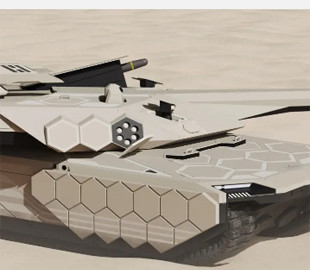
The South Korean company Hyundai Rotem, which is a subsidiary of Hyundai, presented its vision of the future of main battle tanks for the Republic of Korea, which will operate on  ;hydrogen fuel cells.
The new tank K3, the next version of the K series, will be equipped with hydrogen fuel cells and will introduce other modern technologies, becoming one of the most advanced tanks in the world.
It is reported that the development of the new K3 hydrogen tank was carried out in cooperation with the Korean Defense Development Agency and other national scientific institutions. It is planned that the tank will be ready for production by 2040, which will make it the world's first hydrogen-based tank. Hydrogen fuel cells will replace diesel engines. series K, and the transition process will take place gradually, starting with hybrid models on hydrogen and diesel fuel, which is aimed at the transition of military vehicles from internal combustion engines.
«The main battle tank of the new generation surpasses all the capabilities of modern MBTs, ensuring more effective performance of missions with the use of the latest technologies for future combat operations. Hyundai Rotem is actively preparing for future hostilities, developing main battle tanks of a new generation capable of supplementing combat capabilities and performing replacement functions. Ensuring peace is our priority goal — the company emphasized.
200% Deposit Bonus up to €3,000 180% First Deposit Bonus up to $20,000It is known that the new K3 will also receive improved camouflage capabilities, autonomous driving, unmanned drones and a new 130 millimeter smoothbore gun.
Such innovations not only seek to make military assets more resistant to environmental challenges, but also offer significant improvements that should make the new tank more versatile and lethal on the battlefield, particularly among the advantages— reduced thermal signature thanks to the absence of hot exhaust.
Fuel cell technology will also significantly reduce the noise the tank generates while driving, providing better acceleration and mobility, as well as significantly higher fuel economy. With fewer moving parts, the new tank should also have improved serviceability and be able to move better over steep and difficult terrain.
The new K3 will be controlled by three crew members: a driver, a commander and a gunner and will be housed in a heavily armored capsule located near the front of the hull.
The new design of the tank is designed to improve the protection of the crew, isolating them from potential threats from  ;on the side of autoloaders and ammunition storage.
In the basis of the tank's firepower — an unmanned turret with a remotely controlled 130 millimeter smoothbore gun that will allow it to engage targets up to 3 miles (5 kilometers) away. Tank systems will also be equipped with modern armor consisting of modular steel, ceramics and composite materials. In addition, the tank will receive multi-purpose guided anti-tank missiles (ATGM). ) with a range of up to 5 miles (8 kilometers), including advanced modes for line-of-sight and beyond-line-of-sight fire. A remotely controlled fire station on the tower, which can accommodate weapons with a caliber from 12.7 mm to 30 mm, will further improve these capabilities.

